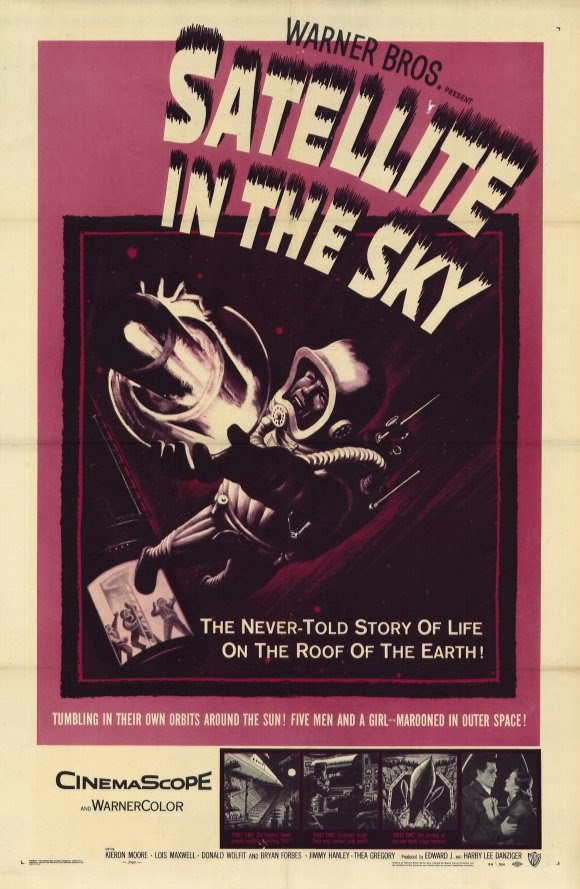Satellite in the Sky is an almost forgotten 1956 British science fiction film. It’s unusual for a British sci-fi offering of this period in being filmed in colour and CinemaScope and on a reasonably lavish budget. Unfortunately it suffers from many of the problems that afflicted 1950s British science fiction movies.
Like Hammer’s early science fiction films (such as Terence Fisher’s Spaceways) it puts much too emphasis on melodrama and as a result it takes an inordinately long time for the actual science fiction to kick in. At 85 minutes it feel rather seriously padded out. It really needed to have about ten minutes trimmed from the first half of the film. It also suffers from some rather serious scripting problems.
The British are about to launch the first manned spacecraft, rather poetically christened the Stardust. Being an ambitious prestige project the launch is accompanied by a great deal of fanfare but certain elements of the project are being kept very high-hush. These top-secret aspects of the mission will have fateful results.
After interminable domestic melodramas involving the crew members and their wives, and feisty girl reporter Kim Hamilton (played by Lois Maxwell, before she became much better known as Miss Moneypenny in the Bond movies), the launch finally gets under way and at first everything seems to go smoothly. Apart from the fact that shortly after blastoff it is discovered that Kim Hamilton has stowed away on the spacecraft.
The real drama comes when the crew members discover that meteorologist Professor Merrity (Donald Wolfit), a last-minute addition to the crew, isn’t a meteorologist at all. He’s a scientist who has developed the ultimate bomb, a bomb that makes the H-bomb seem like a child’s fire cracker. The real object of the Stardust’s mission is to explode this Titanium bomb, known as T-1, in space. This is the only safe way to test the bomb, and the idea is to demonstrate that the British and the Americans now have the ultimate doomsday weapon, a weapon that will make war impossible (of course the movie overlooks the fact that the British intelligence services and the US State Department were so riddled with Soviet spies at that time that within a few weeks the Soviets would undoubtedly have obtained the secret of the Titanium bomb and would have developed their own bomb thus creating another Cold War stalemate).
The problem is that the bomb stubbornly refuses to separate from the spacecraft (a fascinating anticipation of John Carpenter’s much later sci-fi black comedy Dark Star) so the crew are left with two choices - they can either try to land in which case the bomb will explode on Earth thus killing millions of people, or they can remain in orbit to be blown up with the bomb.
The basic story idea is actually a pretty good one. The trouble is that the screenplay (by John Mather, J. T. McIntosh and Edith Dell) fails to capitalise on much of the potential drama. One would think that the discovery of a stowaway would be a big deal, especially as the movie has laboriously established the fact that Kim Hamilton is a bitter opponent of the Stardust project, but in fact her presence on the spacecraft is simply accepted virtually without comment. The fact that the crew members have been lied to about the real mission of the Stardust is also accepted is an unrealistically matter-of-fact way. This is a very talky movie, much too talky, but very little of the talk has anything to do with the very real potential conflicts among the crew.
Director Paul Dickson must also bear some of the responsibility for the failure to develop the kinds of tensions that among the crew that would have made things more interesting.
The acting is reasonably competent, given the fact that the script gives the actors very little to work with. Donald Wolfit indulges in some fairly spectacular scenery-chewing.
Despite all these weaknesses this movie is not a total loss. Visually it’s reasonably impressive. The model work is rather good. The Stardust itself looks very cool indeed and the retractable observation chamber and the strange lift device the crew use to carry out space walks is a very nifty touch. The launch sequence is fairly well done and in general the special effects are considerably better than in most 50s sci-fi movies. The spacecraft interiors look convincing and are filled with cool 1950s-type high-tech equipment. The production values are on the whole top-notch.
Aviation geeks will be excited by some great footage of a very cool British 1950s fighter jet, the Folland Gnat, and of the awesome British Avro Vulcan strategic bomber, surely one of the coolest aircraft ever built.
The Warner Home Video double-bill DVD release pairs this movie with another, much better, sci-fi movie from this era, World Without End. Both movies are presented in their correct aspect ratios in good anamorphic transfers.
Satellite in the Sky might not be a great movie but the visuals are enough to make it worth a look. Given that World Without End is a very good movie this DVD double-bill is an essential purchase for 50s sci-fi fans, and if you’re going to buy it for World Without End you might as well give Satellite in the Sky a spin as well.





No comments:
Post a Comment